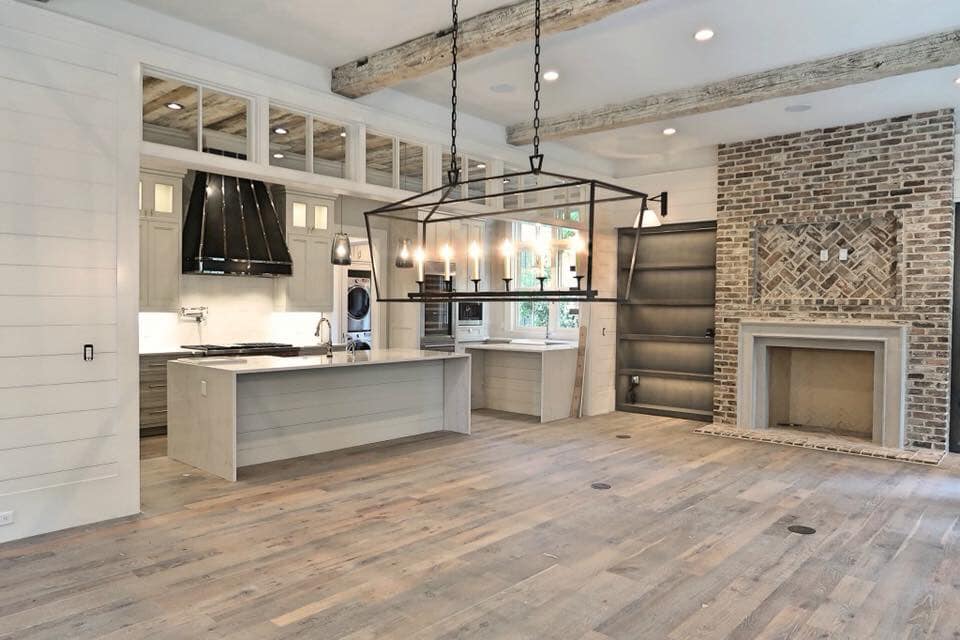It is better to get rigid ducting that should be the same size as the output of the stove hood, with small elbows and direction changes in the short distance possible. Now another question is “can a range hood be vented through the floor”, then yes, you can vent your range hood through the floor. Read below for more information.
Should a range hood be vented?

When the vented hood is mounted under the wall or the cabinet, then the duct runs through or behind the cabinets to the outer wall. For the island range hood or ceiling-mounted range hood, the duct must run above the ceiling.
What is the clearance for a range hood?
Generally, most installations need a distance from 20-24-inches between the bottom of the hood and the cooking surface. Over a gas range, this distance needs to be between 24-30-inches. For more info, please refer to the model’s installation manual. If you have ever forgotten to turn on the fan while trying to get a good crust on a pan full of fish fillets, then you are aware of the importance of better ventilation. Additionally, to whisking away unwanted odors, vent hoods remove grease, moisture, nitrogen dioxide, carbon monoxide, other pollutants that cooking can release into the air. Although these by-products can sound like nuisances, studies have shown that cooking without appropriate ventilation is one cause of poor indoor air quality that may negatively affect your health. That is why the International Residential Code and also the United States Environmental Protection Agency strongly advise homeowners to install a vent hood to capture, filter and then expel the fumes outside via a vent in an exterior wall or on the roof.
As homes have become insulated, and with high-BTU commercial-style ranges ever-famous, appropriate ventilation has become an increasingly essential problem. When picking the right hood you to take into account the power of your range as well as the way you utilize it, but it is a big decision for the kitchen. The great news is that although range hoods are a practical necessity, the variety of available looks has been good; whether you prefer front-and-center utilitarian stainless steel, an insert entirely camouflaged behind cabinetry, an artisan-made copper chimney, or a modernist glass unit, there is a style that will work for you.
What duct’s type is better for venting a range hood?
The rigid duct is a good kind of duct to vent range hood. It needs one-time installation and small to no maintenance as long as you clean range hood filters. The rigid ductwork is manufactured from durable stainless steel, as opposed to rigid ductwork which is made with aluminum or flimsy plastic. A range hood lasts 10+ years with minimal repairs or problems. Occasionally a light will burn out or a control panel can stop working, but ductwork, as long as it is rigid, will remain intact. Otherwise, you’ll probably run into issues within a year. If you rarely cook, the safe, price-efficient bet is to go with rigid ductwork.
What is the difference between a vented range hood and an unvented one?
Vented Range Hoods: The fan in this hood is attached to a duct, so it can move air from the kitchen to the outdoors.
Unvented Range Hoods: An unvented, ductless, range hood has a fan but no duct. Instead of that, it uses many kinds of filters to clean the air, then recirculates the air into the kitchen.
Is it OK to vent the range hood into the attic?
No. You don’t need grease, dirt, chemicals from kitchen air to build up in the attic. It’s better to move it completely out of your house. If you vent hood into the attic, the buildup of dirt and chemicals may be dangerous to your health and is harmful to your house. It is imperative that you vent hood to the exterior of your house, not into the attic, into walls, or between floors.
Where do you vent a range hood?
You can vent a range hood via wall horizontally or via ceiling or via floor also. Wall mount range hoods or under cabinet range hoods are vented horizontally/vertically, although island hoods may be vented vertically. There’s no great way to vent your range hood, but you need to ensure that you have sufficient space behind walls to run the ductwork before proceeding with the installation. Also, it’s a great practice to decrease some elbows in the ductwork. This maximizes the efficiency of airflow, making a path of least resistance. Your ductwork needs to have no more than 3 elbows. Also, make sure that you let 18-inch of space between elbows to keep the amount of resistance manageable. Otherwise, you will experience back-drafting, where air pulled into the hood falls back into the kitchen, this isn’t ideal. Hopefully, these common questions and answers are helpful for you. Hire a professional contractor or HVAC expert for installing your ductwork. A well-done installation will be worth it in the long run, as you will not have to worry about your range hood duct at all. It will let the range hood run more effectively. Remember to keep your filters in top shape too, which will drastically decrease the risk of any future problems with your blower/ductwork.
How far can you vent a range hood?
Your range hood duct shouldn’t exceed 30’ for a straight run, 25’ for a run with one elbow, 20’ for a run with 2 elbows. The shorter the duct, the better. If your ductwork is too long, your kitchen air cannot reach the outside. Back-drafting can happen, where air stays inside your duct, flows back via your hood, and into cooking space.
